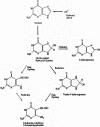Oxidative DNA damage in mild cognitive impairment and late-stage Alzheimer's disease
- PMID: 17947327
- PMCID: PMC2190704
- DOI: 10.1093/nar/gkm821
Oxidative DNA damage in mild cognitive impairment and late-stage Alzheimer's disease
Abstract
Increasing evidence supports a role for oxidative DNA damage in aging and several neurodegenerative diseases including Alzheimer's disease (AD). Attack of DNA by reactive oxygen species (ROS), particularly hydroxyl radicals, can lead to strand breaks, DNA-DNA and DNA-protein cross-linking, and formation of at least 20 modified bases adducts. In addition, alpha,beta-unsaturated aldehydic by-products of lipid peroxidation including 4-hydroxynonenal and acrolein can interact with DNA bases leading to the formation of bulky exocyclic adducts. Modification of DNA bases by direct interaction with ROS or aldehydes can lead to mutations and altered protein synthesis. Several studies of DNA base adducts in late-stage AD (LAD) brain show elevations of 8-hydroxyguanine (8-OHG), 8-hydroxyadenine (8-OHA), 5-hydroxycytosine (5-OHC), and 5-hydroxyuracil, a chemical degradation product of cytosine, in both nuclear and mitochondrial DNA (mtDNA) isolated from vulnerable regions of LAD brain compared to age-matched normal control subjects. Previous studies also show elevations of acrolein/guanine adducts in the hippocampus of LAD subjects compared to age-matched controls. In addition, studies of base excision repair show a decline in repair of 8-OHG in vulnerable regions of LAD brain. Our recent studies show elevated 8-OHG, 8-OHA, and 5,6-diamino-5-formamidopyrimidine in both nuclear and mtDNA isolated from vulnerable brain regions in amnestic mild cognitive impairment, the earliest clinical manifestation of AD, suggesting that oxidative DNA damage is an early event in AD and is not merely a secondary phenomenon.
Figures
References
-
- Evans DA, Funkenstein HH, Albert MS, Scherr PA, Cook NR, Chown MJ, Hebert LE, Hennekens CH, Taylor JO. Prevalence of Alzheimer's disease in a community population of older persons. Higher than previously reported. JAMA. 1989;262:2551–2556. - PubMed
-
- Hebert LE, Scherr PA, Bienias JL, Bennett DA, Evans DA. Alzheimer disease in the US population: prevalence estimates using the 2000 census. Arch. Neurol. 2003;60:1119–1122. - PubMed
-
- American Psychiatric Association. Diagnostic and Statistical Manual of Mental Disorders DSM-IV-TR. 4th. Washington, DC: American Psychiatric Publishing; 2000.
-
- National Institute on Aging and Reagan Institute. Consensus recommendations for the postmortem diagnosis of Alzheimer's disease. Neurobiol. Aging. 1997;18(Suppl. 4):S1–S2. - PubMed
-
- Jost BC, Grossberg GT. The natural history of Alzheimer's disease: a brain bank study. J. Am. Geriatr. Soc. 1995;43:1248–1255. - PubMed
Publication types
MeSH terms
Substances
Grants and funding
LinkOut - more resources
Full Text Sources
Other Literature Sources
Medical


